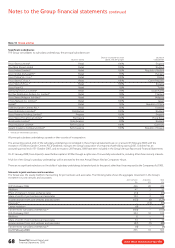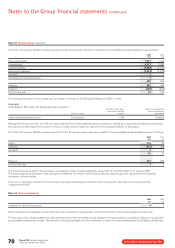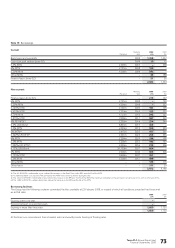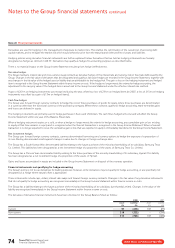Tesco 2008 Annual Report Download - page 80
Download and view the complete annual report
Please find page 80 of the 2008 Tesco annual report below. You can navigate through the pages in the report by either clicking on the pages listed below, or by using the keyword search tool below to find specific information within the annual report.
Tesco PLC Annual Report and
Financial Statements 2008
78 www.tesco.com/annualreport08
Notes to the Group financial statements continued
Note 21 Financial risk factors continued
Sensitivity analysis at 23 February 2008
Financial instruments affected by market risk include borrowings, deposits and derivative financial instruments. The following analysis, required by IFRS 7
‘Financial Instruments: Disclosures’, is intended to illustrate the sensitivity to changes in market variables, being UK interest rates, and foreign exchange risk.
Foreign exchange risk
The Group is exposed to foreign exchange risk principally via:
(a) Transactional exposure, from the cost of future purchases of goods for resale, where those purchases are denominated in a currency other than the
functional currency of the purchasing company. Transactional exposures that could significantly impact the Group Income Statement are hedged.
These exposures are hedged via forward foreign currency contracts which are designated as cash flow hedges. The notional and fair value of these
contracts is shown in note 20.
(b) Net investment exposure, from the value of net investments outside the UK. We hedge the majority of our investments in our international subsidiaries
via foreign currency transactions and borrowings in matching currencies, which are formally designated as net investment hedges.
(c) Loans to non-UK subsidiaries. These are hedged via foreign currency transactions and borrowings in matching currencies, which are not formally
designated as hedges, as gains and losses on hedges and hedged loans will naturally offset.
The impact on Group financial instruments from foreign currency volatility is shown in the sensitivity analysis below.
The analysis excludes the impact of movements in market variables on the carrying value of pension and other post-employment obligations and
on the retranslation of overseas net assets as required by IAS 21 ‘The Effects of Changes in Foreign Exchange Rates’. However it does include the foreign
exchange sensitivity resulting from all local entity non-functional currency financial instruments.
The sensitivity analysis has been prepared on the basis that the amount of net debt, the ratio of fixed to floating interest rates of the debt and derivatives
portfolio, and the proportion of financial instruments in foreign currencies are all constant and on the basis of the hedge designations in place at
23 February 2008.
It should be noted that the sensitivity analysis reflects the impact on income and equity due to all financial instruments held at the Balance Sheet date.
It does not reflect any change in sales or costs that may result from changing interest or exchange rates.
The following assumptions were made in calculating the sensitivity analysis:
> the sensitivity of interest payable to movements in interest rates is calculated on the post hedge floating rate net debt exposure with no sensitivity
assumed for LPI-linked debt;
> changes in the carrying value of derivative financial instruments designated as fair value hedges from movements in interest rates or foreign exchange
rates have an immaterial effect on the Group Income Statement and equity due to compensating adjustments in the carrying value of debt;
> changes in the carrying value of derivative financial instruments designated as net investment hedges from movements in foreign exchange rates
are recorded directly in equity;
> changes in the carrying value of derivative financial instruments not designated as hedging instruments only affect the Group Income Statement;
> all other changes in the carrying value of derivative financial instruments designated as hedging instruments are fully effective with no impact on
the Group Income Statement;
> debt with a maturity below one year is floating rate for the interest payable part of the calculation; and
> the floating leg of any swap or any floating rate debt is treated as not having any interest rate already set, therefore a change in interest rates affects
a full 12-month period for the interest payable portion of the sensitivity calculations.
























